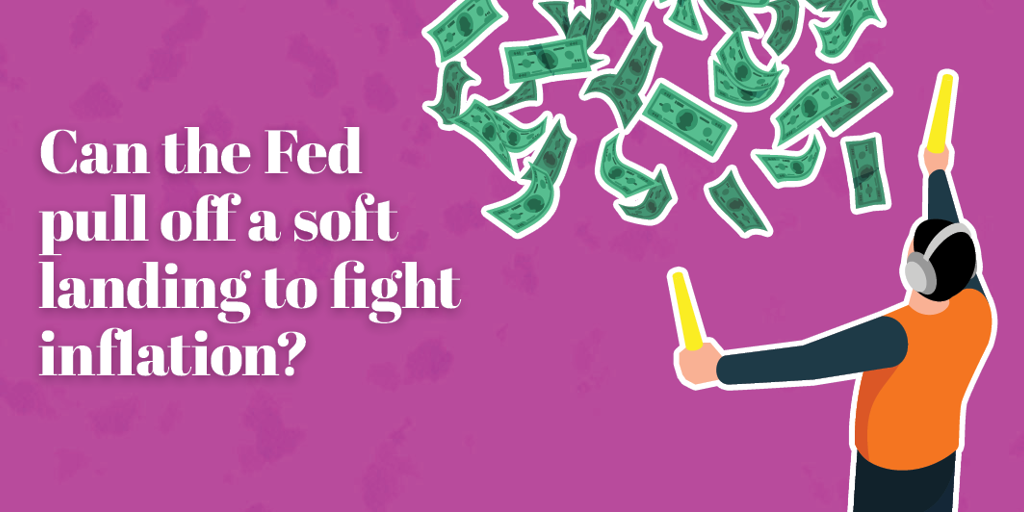


Soft landings require skill; Is the Fed instrument-rated?
As an asset manager and instrument-rated pilot, the term “soft landing” has a different meaning to me than to other watchers of the Federal Reserve.
When it comes to aviation, much of the flying process is amazingly simple. Takeoffs involve lining up on the centerline, giving it full throttle, and putting in a bit of right rudder – if you’re flying a plane with a propeller. Straight and level flight virtually takes care of itself once “trim” is dialed in. Most students can safely fly a plane by their third flight lesson. The rest of pilot training involves emergency procedures, weather, and navigation. The real skill comes in landing.
A properly executed landing involves a “flare” that pitches the nose up and slows the aircraft just above ground level, resulting in a gentle touchdown on the runway (a soft landing). Flare too early or too high and the plane stalls and drops hard on the landing gear. Flare too late or at too high speed and the plane will  bounce. But get it just right and the only sign you are on the ground is the gentle chip of the main gear tires. The “greased landing” is a pilot’s standing ovation. For a central banker, reining in inflation without causing a recession is their standing ovation.
bounce. But get it just right and the only sign you are on the ground is the gentle chip of the main gear tires. The “greased landing” is a pilot’s standing ovation. For a central banker, reining in inflation without causing a recession is their standing ovation.
There is a reason the soft-landing metaphor is used to describe ideal Fed inflation-fighting policy. Orchestrating a soft landing requires skill, analysis, and feel. It can often require quick adjustments to inputs that are not entirely visible. Pilots can’t see a crosswind, but can see evidence in the trees and flags, and it’s a factor that must be managed throughout the landing process. The Fed can’t precisely measure inflationary pressures, but sees evidence in jobs reports and inflation measures. As of February 2023, the Fed has raised interest rates eight consecutive times for a total of 4.5%. The fastest and highest rate hike in modern history was in response to inflation levels not seen in 40 years. These increases can be thought of as deploying economic “flaps” on approach to landing, with the intention being to slow the economy. The real challenge of landing is yet to come.
What makes the Fed’s job particularly difficult is information lag. Much of the data the Fed must use to guide decisions is stale by the time it is published. The GDP report is issued a month after the end of the quarter. Corporate earnings reports reflect earnings from the previous quarter that result from business activity that might be six months to a year old. This means the Fed has limited forward vision upon which to make decisions. In the aviation world, that condition is referred to as Instrument Meteorological Conditions. Under IMC, a pilot has no visual reference to the horizon or any other visual inputs to guide decision-making and must rely entirely on six primary instruments.
Flying in instrument conditions requires hours of specialized training. A pilot seeking an instrument rating will spend as many hours training in instrument conditions as training for a private pilot’s license. Most of that time will be spent practicing approaches and landings. Flying an approach on a precise path at an exact altitude with zero visual references is obviously a challenge. It requires constant processing of data from multiple instruments in real time with little to no confirmation from the outside world. In many ways, this is the Fed’s challenge in managing monetary policy.
Despite the daunting challenge and risk associated with landing an aircraft with no visual outside reference, the Instrument Landing System is remarkably simple. Introduced in the 1930s, the ILS consists of just two needles forming a single crosshair. The vertical needle, or “localizer,” tells the pilot if they are lined up on the centerline of the runway. The horizontal needle, or “glide slope,” lets the pilot know if they are too high or too low on approach. The safe return of everyone on board depends entirely on keeping those two needles centered all the way to the ground. Like economics, the tools and inputs are not complicated, but they require constant monitoring, and one bad decision can lead to unforgiving results.
The Fed also has two primary measures it must monitor – price stability and full employment. Think of price stability as the glide slope. Too much inflation results in an economy coming in too fast for a landing. Depending on the length of the runway, a little too much inflation might not be a big deal. Coming in too fast might result in landing farther down the runway than is ideal, but the bigger risk is coming in too slow and “stalling” the economy before reaching the runway threshold. The result is a spike in unemployment, a significant recession, and the potential for deflation. The full employment mandate is more like the localizer. It tells you the direction you need to be headed, but it can be influenced by multiple outside factors. Impacts from crosswinds like fiscal spending policy and labor regulations can require a heading adjustment to remain on course.
As the Fed approaches the neutral rate (the interest rate that neither stimulates nor restricts economic activity), the landing process begins. To execute a soft landing, the Fed must maintain enough airspeed (economic activity) to keep flying, put in enough flaps (rate hikes) to slow the economy sufficiently to avoid a bounce, and time the flare (rate pause) just perfectly to avoid a hard landing (recession).
A crosswind, zero visibility, zero ceiling landing is the greatest challenge in aviation. Managing a soft landing after record stimulus and 40-year high inflation might be the economic equivalent. Navigating the next 12 months will require not just a good pilot, but a highly skilled instrument-rated pilot. We all hope Fed Chairman Powell is up to the task.
Warren Hurt is Chief Investment Officer for F&M Trust.
Recent Articles
Join our e-newsletter
Sign up for our e-newsletter to get new content each month.






















